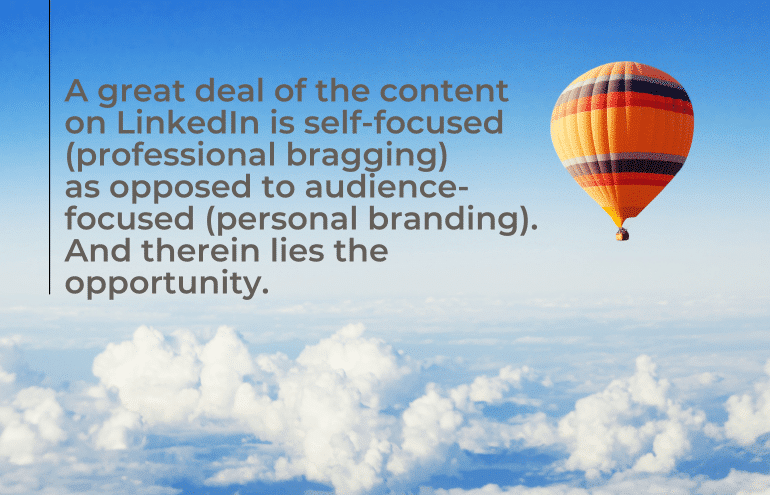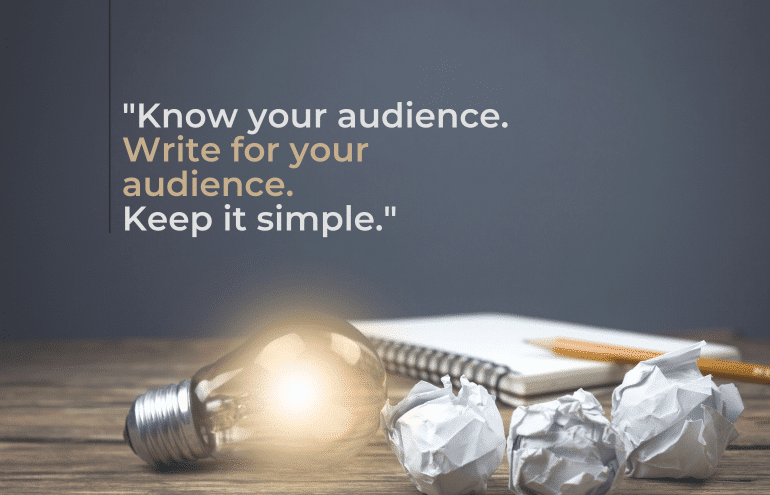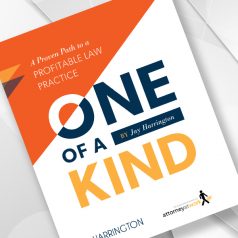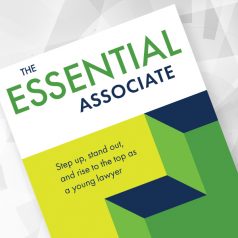A great deal of LinkedIn content shared by lawyers is self-focused as opposed to audience-focused. Therein lies an opportunity.
I graduated from law school as a competent writer, but I had a lot to learn. I still do.
Upon starting my career, one of my mentors, a litigation partner, taught me an important lesson that I didn’t learn in law school:
Know your audience. Write for your audience.
- A seasoned judge doesn’t need a full page and 11 citations on the standard for granting summary judgment.
- General counsel are busy, unimpressed by legalese, and want the key points and conclusion on page 1 of a memo.
And so on.
My mentor called it “writing fluency” — writing that allows the reader to move through the text quickly and effortlessly comprehend the essential message.
As a young associate, I wanted to be perceived as smart and sophisticated. I used a lot of jargon and liked a creative flourish. I needed to kill my darlings.
My mentor explained that my (overly verbose) writing was having the opposite effect and that my goal should be to serve my audience. In almost all cases, audiences appreciate simple and straightforward writing.
Writing on social media platforms, as you might expect, is no different.
Seize the Opportunity on LinkedIn
For most lawyers, rightly so, LinkedIn is the social media platform of choice to create and share content. It’s a global platform of nearly 750 million professionals. LinkedIn statistics suggest that 80% of users are “business decision-makers.” It’s the place to be for lawyers who want to get their ideas in front of prospective clients, establish themselves as thought leaders and build their personal brands.
But LinkedIn, like all social media platforms, is noisy. While there are lots of people clamoring for attention, that doesn’t mean you can’t stand out. A great deal of the content being shared on LinkedIn is self-focused (professional bragging) as opposed to audience-focused (personal branding). And therein lies the opportunity.
Personal branding, when done right, is all about helping others achieve their objectives. And one of the best ways to help your audience on LinkedIn is by creating content.
When you share your ideas, those in your network will come to see you as an expert capable of helping them solve their problems.
Many lawyers hold back their ideas for fear of giving away the “secret sauce.” And this sort of scarcity mindset stops them from realizing the benefits of building a strong personal brand on LinkedIn. In most cases, clients aren’t looking to do it themselves. They’re looking for the right lawyer for the job, and your ideas — your brand — give them confidence in your abilities.
But your ideas will get lost amid the noise if they’re not delivered in a style that resonates with your audience.
How to Write for Your Audience on LinkedIn
On LinkedIn, you’ll gain — not lose — credibility with a more succinct and conversational writing style. Readers will comprehend and retain your ideas more reliably. You’ll reach and affect more people.
Want to impress? Keep it simple.
That’s easier said than done. Easy reading is hard writing. Here are three writing tips to help you create more engaging LinkedIn content.
1. Tell More Stories
For a long time, I shared ideas and advice on LinkedIn but my content gained little traction. Then I made a tweak that had a big impact.
I started telling more stories.
I realized that people didn’t want to be talked at; they wanted to be talked with. Writing about even the most mundane topic can be interesting when wrapped in a story.
Emotions move people, and stories evoke emotions. Stories become persuasive when the protagonist’s struggle reveals an “a-ha” insight.
When creating LinkedIn content, don’t just tell people what they need to know. That’s boring. First, tell a story, and then deliver the key takeaway.
2. Focus on Substance and Form
What you write about on LinkedIn matters. How you write it does, too.
When writing LinkedIn posts, use simple words and short sentences. Brief paragraphs rather than long blocks of text help pull the reader through the post.
If there’s no white space in your post, people will scroll right past it. That’s particularly true on mobile.
Bullet points also help with comprehension and holding attention:
- They’re scannable.
- They emphasize key points.
- They interrupt patterns.
When creating thought leadership content, substance matters most. But as with most things, substance can be enhanced by focusing on form, too.
3. Pay Attention
Ideas are the lifeblood of effective thought leadership marketing. And the best source of good ideas is the audience you hope to serve.
One of the primary benefits of creating content on LinkedIn is that you gain instant feedback on whether your ideas are resonating with your audience, unlike writing for a website or publication.
Are people engaging with your content through likes and comments? If so, you’re on the right track. If not, it’s a signal that you may need to revisit what you’re writing about.
A great way to source good ideas is by paying attention to the content and comments generated by those in your ideal-client audience on LinkedIn. What are the questions being asked? What trends are being discussed?
By paying attention to the “water-cooler” discussions happening on LinkedIn involving those in and around the markets you serve, you gain valuable insights that can inform your own content efforts.
Get Started
Despite all the benefits of creating content on LinkedIn, more lawyers “lurk” than engage on the platform. They’re unsure how to use LinkedIn as a thought leadership platform that can help build their law practices. As with most things, the best way to get started is … to get started.
Creating effective content on LinkedIn is a skill like any other and requires practice. You’ll learn by doing, but always keep in mind: Know your audience. Write for your audience. Keep it simple.
Illustration ©iStockPhoto.com
Subscribe to Attorney at Work
Get really good ideas every day for your law practice: Subscribe to the Daily Dispatch (it’s free). Follow us on Twitter @attnyatwork.
BUSINESS DEVELOPMENT RESOURCES
One of a Kind: A Proven Path to a Profitable Law Practice. In this popular book — part marketing theory, part how-to — attorney, coach and legal marketing expert Jay Harrington teaches how to harness your creativity to develop a profitable niche practice, build your personal brand, increase your visibility, and become a prolific, effective content marketer. Jay draws on his own experience, as well as the experience of successful attorneys who have used the strategies and tactics recommended in the book.
The Essential Associate: Step Up, Stand Out, and Rise to the Top as a Young Lawyer, by Jay Harrington, is for young lawyers who aspire to grow, succeed and advance on a partnership track at a law firm. Jay’s practical, step-by-step guide is aimed at helping new lawyers thrive in today’s competitive law firm environment. It includes insights from dozens of successful lawyers at firms across the country, general counsel at Fortune 500 companies, and top consultants to the legal industry.






















